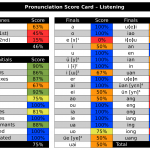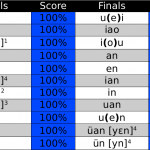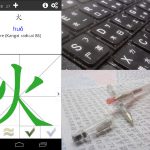Articles in the ‘Key study hacks’ category Page 3
-
Training and testing your ability to hear Mandarin sounds
Learning to hear the sounds in a new language is a very important step, both to understand it and to pronounce it yourself. This article gives you methods and tools for training and testing your ability to hear the sounds of Mandarin.
Read → -
A minimum-effort approach to writing Chinese characters by hand
Learning characters in the first place takes time, but you also need to maintain that knowledge. This article presents an efficient way to remember how to write Chinese characters in the long term.
Read → -
What you intend to write is more important than the character you actually write
Why is focusing on intent important when learning to write Chinese characters? What you intend to write is more important than what you actually write.
Read → -
Focus on initials and finals, not Pinyin spelling
Instead of worrying too much about Pinyin spelling and what sounds each letter represents, students of Mandarin should zoom out a bit and focus on initials and finals as whole units. There are only around 60 of them and focusing on them will pay off handsomely.
Read → -
Study more Chinese: Time boxing vs. micro goals
Time boxing and micro goals are both excellent strategies for getting things done, but which one is most suitable for learning Chinese? In this article, I discuss the pros and cons with the two methods and how that relates to learning Chinese. The short answer is that I use both a lot, but in different situations.
Read → -
7 ways of learning to write Chinese characters
There are many ways of practising writing Chinese characters and they all have their pros and cons. In this article, I discuss seven different ways of practising and what advantages and disadvantages they have for you as a learner. Which do you use?
Read → -
How to reach a decent level of Chinese in 100 days
Scott Young has written a lot about how to learn more efficiently and this year he has turned his focus entirely on languages. He spent three months in China and managed to reach a very decent level of Chinese in that time, including passing HSK4. In this article, he shares his experience and the strategies he used. The article also contains two video interviews, one with John Pasden (Sinosplice) and one with me.
Read → -
Three ways to improve the way you review Chinese characters
In this article, I discuss three things you can do to improve the way you review characters, mainly focusing on avoiding rote learning, time quality and making sure your study method really prepares you for what you want to use your Chinese for. The article also contains a video about how to improve your character reviewing with Skritter!
Read → -
Sensible Chinese character learning revisited
In a way, learning Chinese characters is very much like learning vocabulary in any foreign language and much of the efficient methods developed there works well for Chinese as well. However, characters are also fundamentally different from words in English and this influences how we should learn them as well. This article is a recap of how to learn Chinese characters in a sensible way. It is also a prologue for the upcoming character learning challenge.
Read → -
Phonetic components, part 2: Hacking Chinese characters
This is the second and final article about using phonetic components to hack Chinese characters and make it considerably easier to handle similarly looking characters. This article describes both the principles and gives plenty of examples that might resolve some of your current problems for you.
Read →








